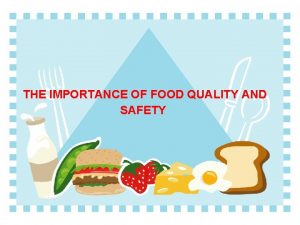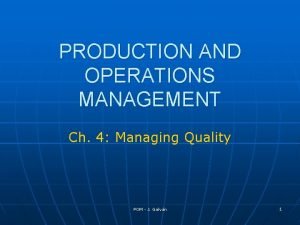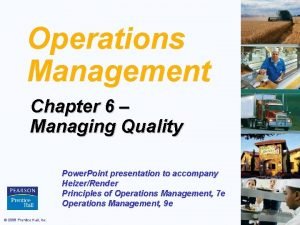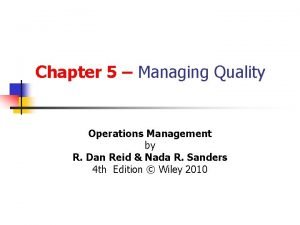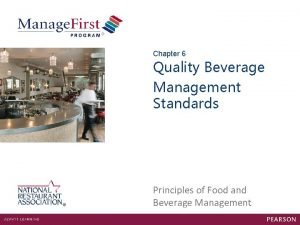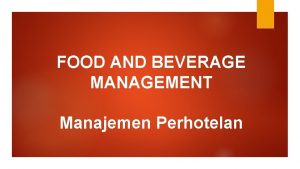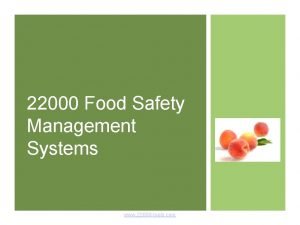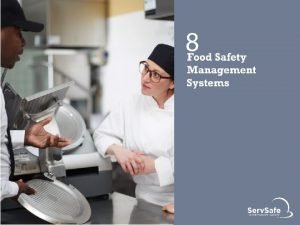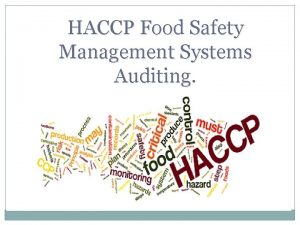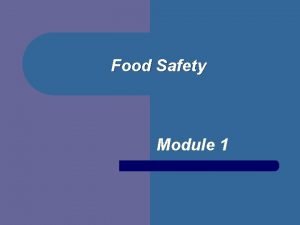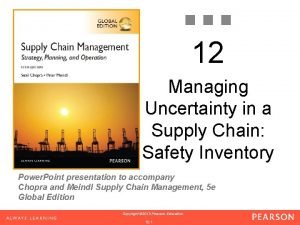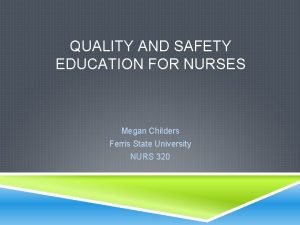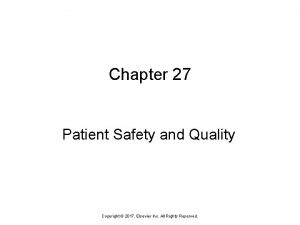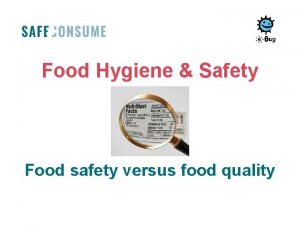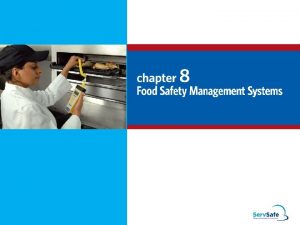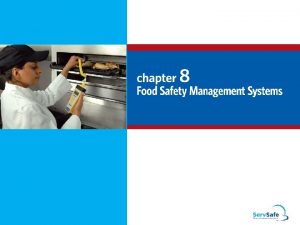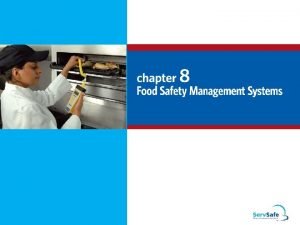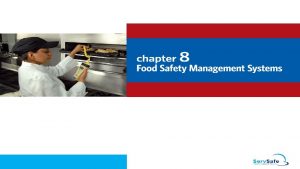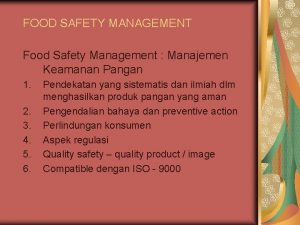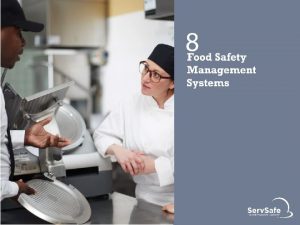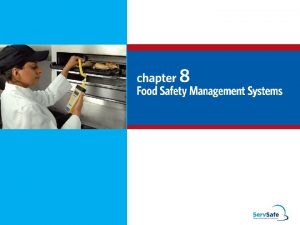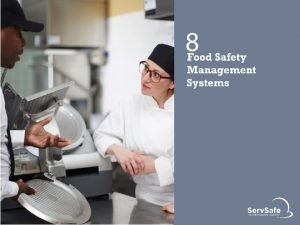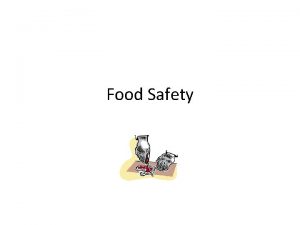Food Safety and Quality Management Managing Quality in

















- Slides: 17

Food Safety and Quality Management Managing Quality in Food Production Systems Michel Siméon, AFTE 1 WB Rural Week, 26 March 1999 1

Managing quality: why? z. Demand for fruits, vegetables and livestock products is growing fast z. Export markets can absorb high value added products and bring high returns z. One key factor is the ability to manage a constant level of quality z. Growing Consumer concern for food safety Michel Siméon, AFTE 1 WB Rural Week, 26 March 1999 2

Quality Standards in International Trade z. WTO / SPS Agreement: standards set by Codex Alimentarius, O. I. E. , I. P. P. C. z. EU harmonization ( standards on raw material, process and end product) z. NAFTA requirements z. Bilateral requirements z. ISO Standards Michel Siméon, AFTE 1 WB Rural Week, 26 March 1999 3

Principle provisions of SPS z. Applied only to the extent necessary to safeguard plant, animal and human health z. Harmonization, no discrimination z. Equivalence: recognize different systems z. Risk assessment and determination of « appropriate level of protection » z. Adaptation to Regional Conditions Michel Siméon, AFTE 1 WB Rural Week, 26 March 1999 4

Differences in Policies z. Large differences exist among similar countries: yhormones dispute yraw-milk cheese yanimal welfare, child labor z. Consumer values versus science-based standards Michel Siméon, AFTE 1 WB Rural Week, 26 March 1999 5

Culture drives policy z. Framing the problem: y «selective vision » of problems depends on culture ythe example of Genetically Modified Organisms (GMOs): the US focuses on the products while UK is concerned with the process, Germany by both Michel Siméon, AFTE 1 WB Rural Week, 26 March 1999 6

Culture drives policy (2) z. Styles of regulation ydifferences in public participation yconflict resolution: political versus judicial z. Acceptable evidence: yformal / quantitative versus qualitative appraisal ymeasurable risk versus precaution z. Forms of expertise: ytechnical / neutral versus affiliation Michel Siméon, AFTE 1 WB Rural Week, 26 March 1999 7

Two basic models z. The old model: yone by one inspection at the end of the chain yzero tolerance z. The new model: yquality management throughout the chain ystandards based on risk assessment Michel Siméon, AFTE 1 WB Rural Week, 26 March 1999 8

Modern Chain Based Quality Control Systems z. Total quality control (ISO 9000 series) z. Hazard Analysis and Critical Control Point system (HACCP) z. Standard operating procedures (e. g. GMP, GLP, . . . ) Michel Siméon, AFTE 1 WB Rural Week, 26 March 1999 9

ISO 9000 A Quality Assurance System z. ISO 9000 mandates that an organization: ydefines appropriate quality standards, ydocuments its processes, and yproves that it consistently adheres to both. z. ISO 9000 does not specify HOW a particular organization should operate! Michel Siméon, AFTE 1 WB Rural Week, 26 March 1999 10

ISO 9000 Certification z Companies can register for ISO 9000 certification. z Assures customers about suppliers capabilities and systems to provide quality goods and services. z The US Do. D is switching to ISO 9000 z EU requires ISO 9000 registration for 35 product categories. z Japan requires ISO 9000 registration for companies wishing to market products and services. Michel Siméon, AFTE 1 WB Rural Week, 26 March 1999 11

ISO 9000 shortcomings z. Does not always guarantee high-quality products. z. ISO 9000 standards focus mainly on traditional manufacturing businesses. z. While improvements can lead to savings and higher profits, the cost of ISO 9000 certification is over $200, 000 Michel Siméon, AFTE 1 WB Rural Week, 26 March 1999 12

Hazard Analysis and Critical Control Point system z. Control is transferred from end product testing to a number of points of the manufacturing chain of foods z. Testing for failure is replaced by preventing failure z. Some end product testing still required for on-going verification of the process. Michel Siméon, AFTE 1 WB Rural Week, 26 March 1999 13

Key features of HACCP z. It provides a more structured approach than traditional procedures. z. Developed in the 1960’s for NASA to guarantee total food safety for astronauts z. Now part of the Codex Alimentarius z. Now required of all food businesses in Europe under EC Directive 93/43. Michel Siméon, AFTE 1 WB Rural Week, 26 March 1999 14

The 7 Components of HACCP 1: Conduct a hazard analysis 2: Identify the Critical Control Points 3: Establish target level(s) and tolerance(s) for keeping each CCP under control 4: Establish a monitoring system of the CCPs 5: Establish corrective action to be taken when a particular CCP is moving out of control 6: Document all procedures and keep records 7: Establish verification procedures Michel Siméon, AFTE 1 WB Rural Week, 26 March 1999 15

Managing food hazards Elements of effective programs z. Sound export / import regulations z. Up-to-date active disease surveillance and information systems z. Efficiently functioning plant protection and veterinary services z. Alert field professionals and public health officials z. Full cooperation of industries Michel Siméon, AFTE 1 WB Rural Week, 26 March 1999 16

Areas for World Bank support z. Policy dialogue and sector work to help client countries to: y. Be in a position to influence international negotiations and standards setting y. Adapt ISO 9000 and HACCP to local conditions z. Develop institutional capacity (public, private) through: y. Training in quality management, risk analysis, markets requirements, . . . y. Investment in facilities: Laboratories, border stations, quality testing Michel Siméon, AFTE 1 WB Rural Week, 26 March 1999 17
 We need quality food justify
We need quality food justify Managing quality in operations management
Managing quality in operations management Chapter 6 managing quality
Chapter 6 managing quality Managing quality in operations management
Managing quality in operations management Food safety food security
Food safety food security Quality management principles in food and beverage company
Quality management principles in food and beverage company Unit 2 food food food
Unit 2 food food food Sequence of food chain
Sequence of food chain Food and beverage preparation service management
Food and beverage preparation service management Health and safety management system template
Health and safety management system template 22000-tools.com
22000-tools.com Active managerial control software
Active managerial control software Food safety assurance
Food safety assurance Food safety management arkansas
Food safety management arkansas Managing uncertainty in supply chain safety inventory
Managing uncertainty in supply chain safety inventory Contemporary issues in management ppt
Contemporary issues in management ppt Quality and safety education for nurses
Quality and safety education for nurses Chapter 27 patient safety and quality
Chapter 27 patient safety and quality
